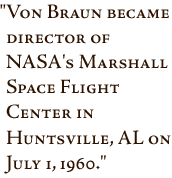

With 120 of his associates, von Braun was brought to the U.S. as part of "Operation Paperclip" in order to demonstrate their achievements with V-2 rockets. He arrived in the U.S. in September 1945 under contract to the U.S. Army. During the following five years, he directed high-altitude firings of V-2 rockets at the White Sands Missile Range in New Mexico and was project director of the guided missile development unit at Fort Bliss, Texas.
In 1950, the Fort Bliss rocket development group was transferred to Huntsville, Alabama, where the Army centered its rocket development activities. In Huntsville, the von Braun team worked on the ballistic rockets called Redstone, Jupiter C, Juno, and the Saturn 1B. After the Soviets' Sputnik went into orbit in 1957 and the Navy's Vanguard rocket blew up on its pad, a version of von Braun's Redstone rocket, called Jupiter-C, put Explorer 1 into orbit in 1958, and another version carried Alan Shepard on the first U.S. sub-orbital flight in 1961.
Von Braun and his team were transferred from the Army's control to NASA's when the National Aeronautics and Space Administration was established in 1958. Von Braun became director of NASA's Marshall Space Flight Center (MSFC) in Huntsville, which was dedicated on July 1, 1960. The von Braun team members were given a choice whether to go to NASA or stay with the Army Ballistic Missile Agency. All elected to be transferred to MSFC on this same date. Von Braun's management style was to let everybody on the team know that they were important to its success and that any work they did was a reflection on the team. The result was that every team member did his best.
When President Kennedy called for a Moon landing within the decade, von Braun was asked to lead the effort to design and build the rocket. The Saturn V, developed by MSFC, won the race with the Soviet Union to put the first men on the Moon in 1969. After the Moon landings, at the insistence of the NASA Administrator, von Braun, in 1970, went to NASA Headquarters in Washington, D.C. to serve as Deputy Associate Administrator and to promote space activities. But public interest and support had declined, and von Braun resigned in May 1972 to become vice president for engineering and development at Fairchild Industries, Inc.
In 1975, he founded and became the first president of the National Space Institute, a private group designed to increase public understanding and support of space activities. Von Braun died on June 16, 1977, and was buried in Washington, D.C. next: References
|
 On the Shoulders of Giants
| ||